Rational Equations: Practice Problems - Quiz
Choose your answer and write the correct one down. Then click HERE for the answers to this quiz.
NOTE: The transcript from the video is listed below the quiz for your reference.
1.

2.
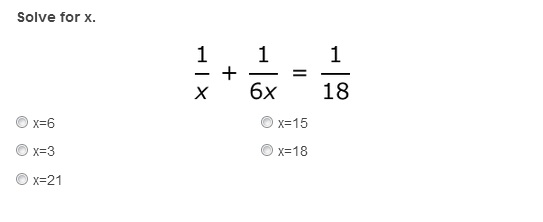
3.
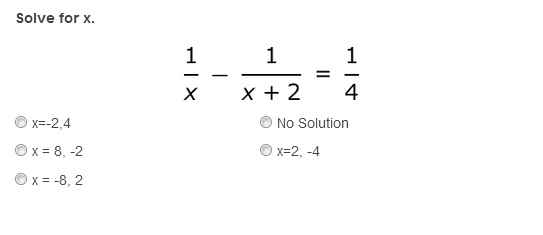
4.
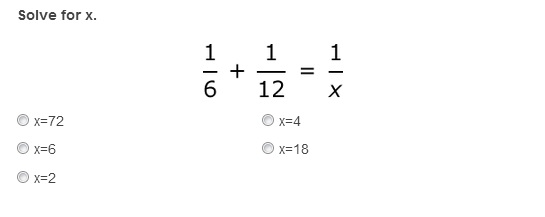
5.
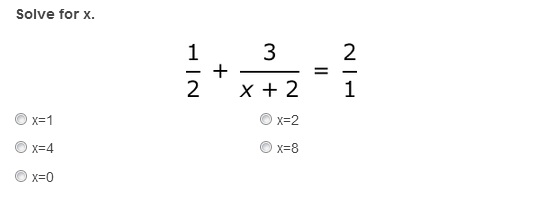
Mario and Bill own a local carwash and have several complex tasks that they must use rational equations to solve for an answer. Enjoy learning how they solve these equations to help them with some of their day-to-day tasks.
Example 1
 |
Mario and Bill own a local carwash. Mario can wash, vacuum, and wax a car in 6 hours. Bill can wash a car, vacuum the car, and wax a car in 5 hours. They've decided to have a special event on the upcoming Saturday. The two are curious how long it will take them to wash, vacuum, and wax each car if they work together, so they decide to figure out how long it should take them. They decide to write a rational equation to represent their situation. A rational equation is an equation that contains fractions and has polynomials in its numerator and denominator.
Mario knows that he can clean a car in 6 hours. He needs to use the rate of 1 car for every 6 hours. Bill knows that he can clean a car in 5 hours. He will need to use the rate of 1 car for every 5 hours. Since they do not know how long it will take them to clean a car together, they are going to use the variable w to represent that time. So the rate that they will clean a car together will be 1 car for every w hours.
Mario and Bill know that each of their rates added together will equal the amount of time it would take them combined, so they will use the equation Mario's rate + Bill's rate = their combined rate. Next, they will plug in each rate into their equation: 1/6 + 1/5 = 1/w. Mario and Bill are now ready to solve their problem to see how long it would take them together to clean each car.
Clearing the Fraction
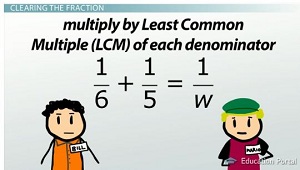 |
Mario and Bill are both perplexed when looking at their equation. They both know that in order to solve an equation with fractions, they can clear the fractions from the equation. To do this, they will need to multiply each term by the least common multiple (LCM) of each denominator. The denominators in the problem are 6, 5, and w. The LCM of the two numbers (6 and 5) is 30. They must also multiply by the variable w since it is also a term. So the LCM of these three denominators is 30w. By multiplying each term in this equation by 30w, Mario and Bill can clear out all of the fractions in their equation. The reason that this is possible is because when they multiply each term, they can cancel out the common terms.
When doing 1/6 times 30w, we can divide out a common factor of 6. So 1/6 times 30w would equal 5w. When multiplying 1/5 times 30w, we can divide out a common factor of 5. So 1/5 times 30w would equal 6w. When doing 1/w times 30w, we can divide out a common factor of w. So 1/w times 30w would equal 30. Now that Mario and Bill have multiplied each term by 30w, they now have the equation 5w + 6w = 30.
Solving Example 1
The next step to solving this problem is to combine like terms: 5w + 6w = 11w. The equation now is a one-step equation: 11w = 30. To solve for w, divide each side by 11. 11w divided by 11 would equal w, and 30 divided by 11 would equal 2 and 8/11 hours. To find out exactly how many minutes 8/11 hours is, Mario and Bill would multiply 8/11 times 60 minutes. This would equal 43.6 minutes. Adding that to the whole number of 2, Mario and Bill realize that together they can wash, vacuum, and wax each car in 2 hours and 43.6 minutes.
Example 2
Mario and Bill are very happy with the turnout during their Saturday sale. They had so many customers that they decided to work together to sanitize the inside of their carwash. Together, it took them 12 hours to completely sanitize the inside of their carwash. The last time the carwash was sanitized, Mario had cleaned it himself. The year before, Bill had cleaned the carwash by himself but took 3 times as long as Mario had taken by himself. How long had it taken each one of them to clean the carwash individually?
 |
We know that Mario cleaned the carwash by himself, but we do not know how long that took. Let's use the ratio 1 carwash in M hours to represent how long it took Mario to clean the carwash by himself. Also, Bill cleaned the carwash by himself. For Bill we will use the ratio 1 carwash in B hours to represent how long it took Bill to clean the carwash by himself. Together they cleaned the carwash in 12 hours. For this ratio we will use 1 carwash in 12 hours to represent how fast they cleaned the carwash while working together. We can now see that Mario's time plus Bill's time equals their combined time. So our equation is now 1/M + 1/B = 1/12.
We now know that it took Bill three times as long as it took Mario to clean the carwash by himself. Therefore, instead of using B to represent the amount of time it took Bill, we can use 3M because 3M would represent three times the number of hours it took Mario. To solve this equation, we now need to clear the fractions from the equation by multiplying by the LCM. The least common multiple that will divide by our denominators M, 3M, and 12 is 12M. So we are going to multiply each term by 12M. This will allow us to get rid of our fractions.
1/M times 12M equals 12. 1/3M times 12M equals 4. And finally, 1/12 times 12M equals M. So our equation now looks like 12 + 4 = M. To solve, add 12 and 4 together, and M would equal 16. Since M equals 16, we know that it took Mario 16 hours to clean the carwash by himself. It took Bill 3 times as long, so 16 * 3 = 48 hours. Bill cleaned the carwash himself in 48 hours. He must have had a long week.
Example 3
Mario and Bill are so pleased with their sparkling clean carwash. The two guys only have one more task to make their carwash completely stocked for the next day's opening. They need to fill the large soap tower.
Mario and Bill can use two separate hoses to fill the soap dispenser. When both hoses are being used together, it takes 12 minutes to fill the soap tower. If used separately, one hose can fill the tower 10 minutes faster than the other hose. How long does it take each hose to fill the tower separately?
For this problem, let's call hose A the faster hose and hose B the slower hose. The ratio for how fast hose A can fill the soap tower alone is 1 tower/A minutes. The ratio for how fast hose B can fill the tower alone is 1 tower/B minutes. Also, the ratio for how fast both hoses combined can fill the water tower is 1 tower/12 minutes. We now know that when we use hose A plus hose B combined it takes 12 minutes. So our equation will be 1/A + 1/B = 1/12.
Since it takes hose B 10 minutes longer than hose A, we can substitute A + 10 in for term B. Our equation is now 1/A + 1/A+ 10 = 1/12. The easiest way to clear our equation of fractions is to multiply each term by the LCM, which would be all three denominators multiplied together. The LCM for this equation would be A times A+10 times 12.
As we multiply each term, we can cancel out the like terms. As we multiply 1/A times A times A+ 10 times 12, the A terms will cancel out, leaving (A + 10) times 12. As we multiply 1/(A + 10) times A times A + 10 times 12, the (A + 10) terms will cancel out, leaving A times 12. And as we multiply 1/12 times A times A + 10 times 12, the 12 terms will cancel out, leaving A times (A + 10). Our equation is now ((A + 10) * 12) + (A * 12) = (A * (A + 10)).
Next we need to simplify each term. 12 times (A + 10) would equal 12A + 120. 12 times A would equal 12A, and A times (A + 10) would equal A^2 + 10A. Next, let's combine 12A and 12A on the same side of our equation to equal 24A. So our equation now is 24A + 120 = A^2 + 10A.
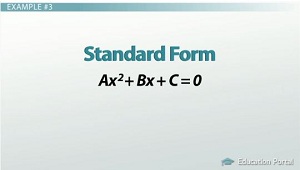 |
The equation now needs to be put into standard form so that we can factor out the possible solutions. Standard form is written as Ax2 + Bx + C = 0. To convert our equation to standard form, we will need to perform inverse operations. Our equation in standard form would be written as A^2 - 14A - 120 = 0.
To solve this equation, we need to factor our trinomial. Look at our constant, -120. We need to think of two numbers that multiply together to give us -120 but also add together to give us our middle term of -14. The two factors of 120 that that gives us a product of -120 and a sum of -14 are -20 and 6. When we factor the equation A^2 - 14A - 120, we get (A - 20) and (A + 6) = 0. We must solve each term by setting both equations equal to zero. We will solve the equations (A - 20) = 0 and (A + 6) = 0.
After solving both of these equations, we are left with two solutions - A = 20 and A = -6. Mario and Bill both know that it is not possible to have a negative hour, so they eliminate the answer A = -6. So Mario and Bill now know that hose A, which is the fastest hose, took 20 minutes to fill up the soap tower by itself. To find out how long it took hose B, we will need to add the 20 minutes and the additional 10 minutes that the slower hose took, so hose B took 30 minutes to fill up the soap tower. Mario and Bill are now pleased with their clean carwash and ready to start another busy week of working at the carwash.
Lesson Summary
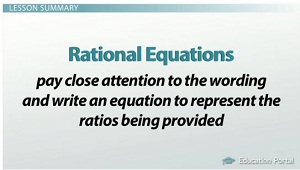 |
Let's review some of the main points that we used to solve these rational equations. To solve a rational equation, you will need to pay close attention to the wording of the problem and write an equation to represent the ratios that are provided. The easiest way to solve a rational equation is by clearing the equation of fractions. This can be done by multiplying each term by the least common multiple (LCM). After you clear the equation of the fractions, you will solve the equation the same way as you would any other multi-step equation. Don't forget at the end of your problem to evaluate your answer to check if it makes sense. For example, we could not have -6 hours. Therefore, -6 was not a possible solution.